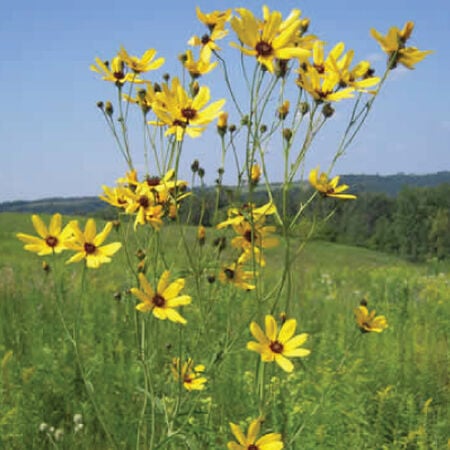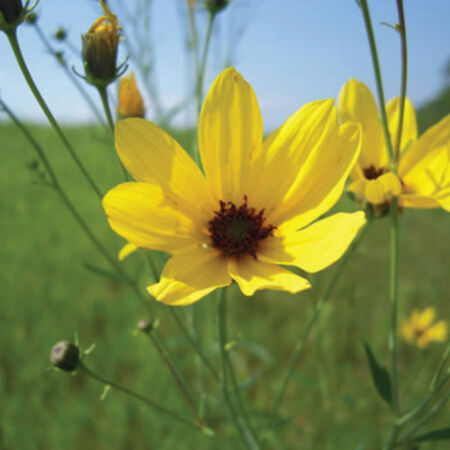Tall, Coreopsis Seeds
Key Attributes
Product Details
Weight
0.01Depth
0.1Height
4.5Width
3.25Plant Height
30-48"Botanical Name
Coreopsis TripterisSeed Type
SeedSeeds Per Gram
494Seeds Per Pound
224,000Packet
100 SeedsSow Depth
1/2"Seeds Per Ounce
14,000Breed
Open-pollinatedSun
Full Sun / Partial ShadeLife Cycle
PerennialSow Method
TransplantCategories
FlowersDays To Maturity (# Days)
75Components
Growing Instructions
![]() Learning Download: How to Grow Coreopsis
Learning Download: How to Grow Coreopsis
Coreopsis, also known as tickseed or pot of gold, is a long-lasting flower that grows in most any area in the United States. The plant is referred to as tickseed because its seeds resemble ticks.
Before Planting: Coreopsis are an easy flower to grow, and all they need is to be planted in an area that receives full sun.
Planting: The seeds require light to germinate, so don’t cover them and just press them lightly into the soil. Plant more seeds in succession to have Coreopsis blooms all summer long.
Watering: Coreopsis are native to the United States, and they only require watering during the extreme droughts.
Fertilizer: Coreopsis do not require fertilization. Fertilization can actually decrease the flower production.
Days to Maturity: Many kinds of Coreopsis will begin blooming in the early summer and last until fall.
Harvesting: Although Coreopsis self-sow, it is also possible to save the seeds for future planting. To do so, wait until after the flowers have bloomed and the petals begin to fall away from the center. Harvest the seed head while it is still tightly formed enough to keep the seeds enclosed. Snip off the seed head and open it to extract the seeds.
Tips: Cut the flowers back by one-third each summer, as this will encourage a continued display of blooms.
Shipping Schedule
Our Seed Promise
 "Agriculture and seeds" provide the basis upon which our lives depend. We must protect this foundation as a safe and genetically stable source for future generations. For the benefit of all farmers, gardeners and consumers who want an alternative, we pledge that we do not knowingly buy or sell genetically engineered seeds or plants.
"Agriculture and seeds" provide the basis upon which our lives depend. We must protect this foundation as a safe and genetically stable source for future generations. For the benefit of all farmers, gardeners and consumers who want an alternative, we pledge that we do not knowingly buy or sell genetically engineered seeds or plants.
The mechanical transfer of genetic material outside of natural reproductive methods and between genera, families or kingdoms, poses great biological risks as well as economic, political, and cultural threats. We feel that genetically engineered varieties have been insufficiently tested prior to public release. More research and testing is necessary to further assess the potential risks of genetically engineered seeds. Further, we wish to support agricultural progress that leads to healthier soils, to genetically diverse agricultural ecosystems, and ultimately to healthy people and communities.
To learn more about the "Safe Seed Pledge" please visit www.councilforresponsiblegenetics.org.
Key Attributes
Product Details
Weight
0.01Depth
0.1Height
4.5Width
3.25Plant Height
30-48"Botanical Name
Coreopsis TripterisSeed Type
SeedSeeds Per Gram
494Seeds Per Pound
224,000Packet
100 SeedsSow Depth
1/2"Seeds Per Ounce
14,000Breed
Open-pollinatedSun
Full Sun / Partial ShadeLife Cycle
PerennialSow Method
TransplantCategories
FlowersDays To Maturity (# Days)
75Components
Growing Instructions
![]() Learning Download: How to Grow Coreopsis
Learning Download: How to Grow Coreopsis
Coreopsis, also known as tickseed or pot of gold, is a long-lasting flower that grows in most any area in the United States. The plant is referred to as tickseed because its seeds resemble ticks.
Before Planting: Coreopsis are an easy flower to grow, and all they need is to be planted in an area that receives full sun.
Planting: The seeds require light to germinate, so don’t cover them and just press them lightly into the soil. Plant more seeds in succession to have Coreopsis blooms all summer long.
Watering: Coreopsis are native to the United States, and they only require watering during the extreme droughts.
Fertilizer: Coreopsis do not require fertilization. Fertilization can actually decrease the flower production.
Days to Maturity: Many kinds of Coreopsis will begin blooming in the early summer and last until fall.
Harvesting: Although Coreopsis self-sow, it is also possible to save the seeds for future planting. To do so, wait until after the flowers have bloomed and the petals begin to fall away from the center. Harvest the seed head while it is still tightly formed enough to keep the seeds enclosed. Snip off the seed head and open it to extract the seeds.
Tips: Cut the flowers back by one-third each summer, as this will encourage a continued display of blooms.
Shipping Schedule
Our Seed Promise
 "Agriculture and seeds" provide the basis upon which our lives depend. We must protect this foundation as a safe and genetically stable source for future generations. For the benefit of all farmers, gardeners and consumers who want an alternative, we pledge that we do not knowingly buy or sell genetically engineered seeds or plants.
"Agriculture and seeds" provide the basis upon which our lives depend. We must protect this foundation as a safe and genetically stable source for future generations. For the benefit of all farmers, gardeners and consumers who want an alternative, we pledge that we do not knowingly buy or sell genetically engineered seeds or plants.
The mechanical transfer of genetic material outside of natural reproductive methods and between genera, families or kingdoms, poses great biological risks as well as economic, political, and cultural threats. We feel that genetically engineered varieties have been insufficiently tested prior to public release. More research and testing is necessary to further assess the potential risks of genetically engineered seeds. Further, we wish to support agricultural progress that leads to healthier soils, to genetically diverse agricultural ecosystems, and ultimately to healthy people and communities.
To learn more about the "Safe Seed Pledge" please visit www.councilforresponsiblegenetics.org.




